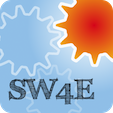 | |||||
Splinter - Radio Heliophysics Infrastructure for Space Weather Science and OperationsM. Bisi (RAL Space) and D. R. Jackson (Met Office)Tuesday 18th, 15:30 - 17:00 Radio Heliophysics is an umbrella term covering a plethora of scientific radio-astronomy techniques to study the Sun, the corona, the solar wind (including quiescent outflow, interaction, and transient outflow such as coronal mass ejections – CMEs), the Earth, and the planets. Many of these data types can be used in space-weather science and operations. However, there are few well-defined services which can be easily employed for space-weather forecasting at present, and most that do exist have not yet undergone thorough validation and testing as forecast tools despite extensive use in scientific investigations over years resulting in hundreds if not thousands of scientific publications. This splinter focusses on two techniques in particular: interplanetary scintillation (IPS) and Faraday rotation (FR). The former observing technique has been used to study the solar wind in the inner heliosphere using a wide variety of methods since the 1960s. The latter has been used in radio astronomy for almost as long and has had some sporadic use in coronal investigations, but is yet to undergo any vigorous testing for solar wind science or space-weather applications. This splinter will review current activities and initiatives that are ongoing, both in Europe and worldwide. It will review the progress for a consolidated IPS data format for wider community use, and it will go on to investigate potential applicability of both IPS and FR in terms of space-weather forecasting, as well as how current methods and models can be validated and improved where deemed a necessity for space-weather forecasting capabilities. Time allowing, the complementarity of IPS and FR to other forecasting methods will also be addressed. Since several key IPS observers, modellers (including MHD modellers), and data-analyses types will be at the European Space Weather Week (ESWW) this year for at least some part, now is a good time to host this mini workshop as a splinter at ESWW. In addition, IPS will likely have a higher profile later in 2014 and through to early 2016 with the possible loss of the majority of space-weather/heliospheric imager data from both STEREO spacecraft as they transit the far side of the Sun. Program10 minutes presentations on
Back to the splinter overview |
| ||||
|
| |||||







